Business Analytics Principles: Roy Morgan Segments & Melbourne Rail
VerifiedAdded on 2023/06/10
|7
|1451
|455
Report
AI Summary
This report provides an analysis of Roy Morgan Value Segments and their application to Melbourne's rail network planning. It explores how these segments can be used to understand customer needs and buying behaviors, focusing on segments like "Visible Achievement," "Conventional and Tradition...
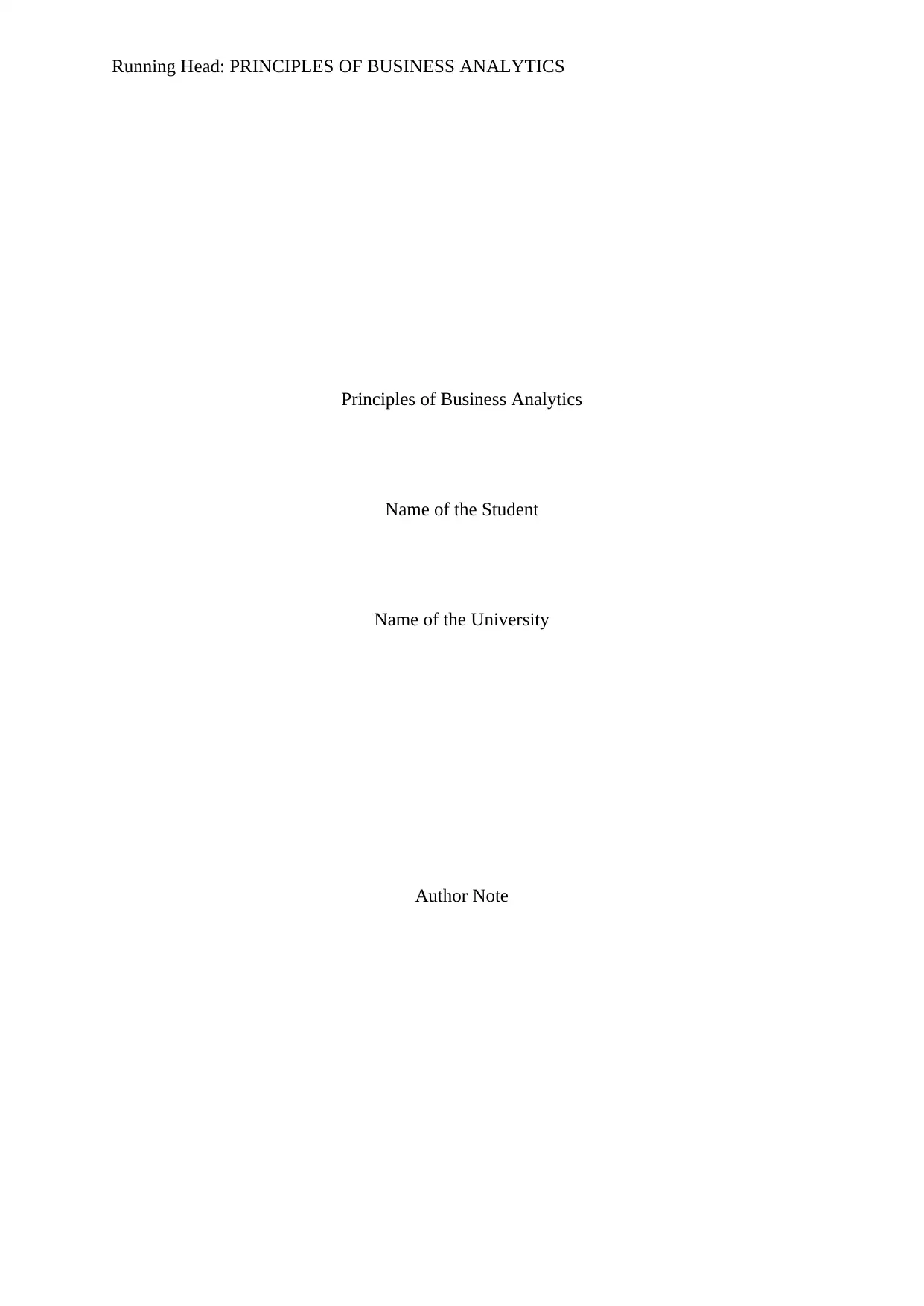
Running Head: PRINCIPLES OF BUSINESS ANALYTICS
Principles of Business Analytics
Name of the Student
Name of the University
Author Note
Principles of Business Analytics
Name of the Student
Name of the University
Author Note
Paraphrase This Document
Need a fresh take? Get an instant paraphrase of this document with our AI Paraphraser

1PRINCIPLES OF BUSINESS ANALYTICS
Table of Contents
Roy Morgan Value Segments....................................................................................................2
Data Collection Methodology....................................................................................................4
References..................................................................................................................................6
Table of Contents
Roy Morgan Value Segments....................................................................................................2
Data Collection Methodology....................................................................................................4
References..................................................................................................................................6
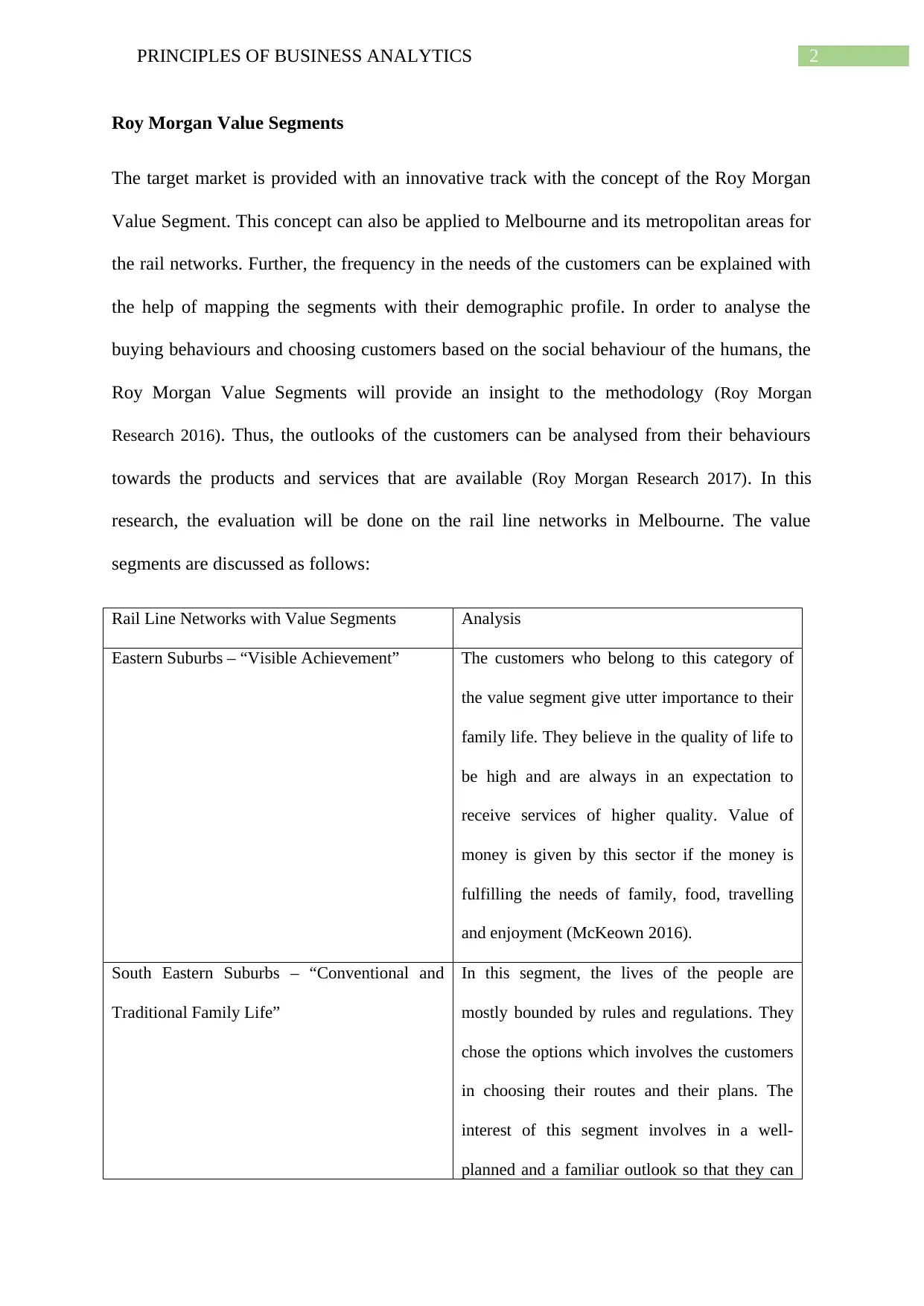
2PRINCIPLES OF BUSINESS ANALYTICS
Roy Morgan Value Segments
The target market is provided with an innovative track with the concept of the Roy Morgan
Value Segment. This concept can also be applied to Melbourne and its metropolitan areas for
the rail networks. Further, the frequency in the needs of the customers can be explained with
the help of mapping the segments with their demographic profile. In order to analyse the
buying behaviours and choosing customers based on the social behaviour of the humans, the
Roy Morgan Value Segments will provide an insight to the methodology (Roy Morgan
Research 2016). Thus, the outlooks of the customers can be analysed from their behaviours
towards the products and services that are available (Roy Morgan Research 2017). In this
research, the evaluation will be done on the rail line networks in Melbourne. The value
segments are discussed as follows:
Rail Line Networks with Value Segments Analysis
Eastern Suburbs – “Visible Achievement” The customers who belong to this category of
the value segment give utter importance to their
family life. They believe in the quality of life to
be high and are always in an expectation to
receive services of higher quality. Value of
money is given by this sector if the money is
fulfilling the needs of family, food, travelling
and enjoyment (McKeown 2016).
South Eastern Suburbs – “Conventional and
Traditional Family Life”
In this segment, the lives of the people are
mostly bounded by rules and regulations. They
chose the options which involves the customers
in choosing their routes and their plans. The
interest of this segment involves in a well-
planned and a familiar outlook so that they can
Roy Morgan Value Segments
The target market is provided with an innovative track with the concept of the Roy Morgan
Value Segment. This concept can also be applied to Melbourne and its metropolitan areas for
the rail networks. Further, the frequency in the needs of the customers can be explained with
the help of mapping the segments with their demographic profile. In order to analyse the
buying behaviours and choosing customers based on the social behaviour of the humans, the
Roy Morgan Value Segments will provide an insight to the methodology (Roy Morgan
Research 2016). Thus, the outlooks of the customers can be analysed from their behaviours
towards the products and services that are available (Roy Morgan Research 2017). In this
research, the evaluation will be done on the rail line networks in Melbourne. The value
segments are discussed as follows:
Rail Line Networks with Value Segments Analysis
Eastern Suburbs – “Visible Achievement” The customers who belong to this category of
the value segment give utter importance to their
family life. They believe in the quality of life to
be high and are always in an expectation to
receive services of higher quality. Value of
money is given by this sector if the money is
fulfilling the needs of family, food, travelling
and enjoyment (McKeown 2016).
South Eastern Suburbs – “Conventional and
Traditional Family Life”
In this segment, the lives of the people are
mostly bounded by rules and regulations. They
chose the options which involves the customers
in choosing their routes and their plans. The
interest of this segment involves in a well-
planned and a familiar outlook so that they can
⊘ This is a preview!⊘
Do you want full access?
Subscribe today to unlock all pages.

Trusted by 1+ million students worldwide
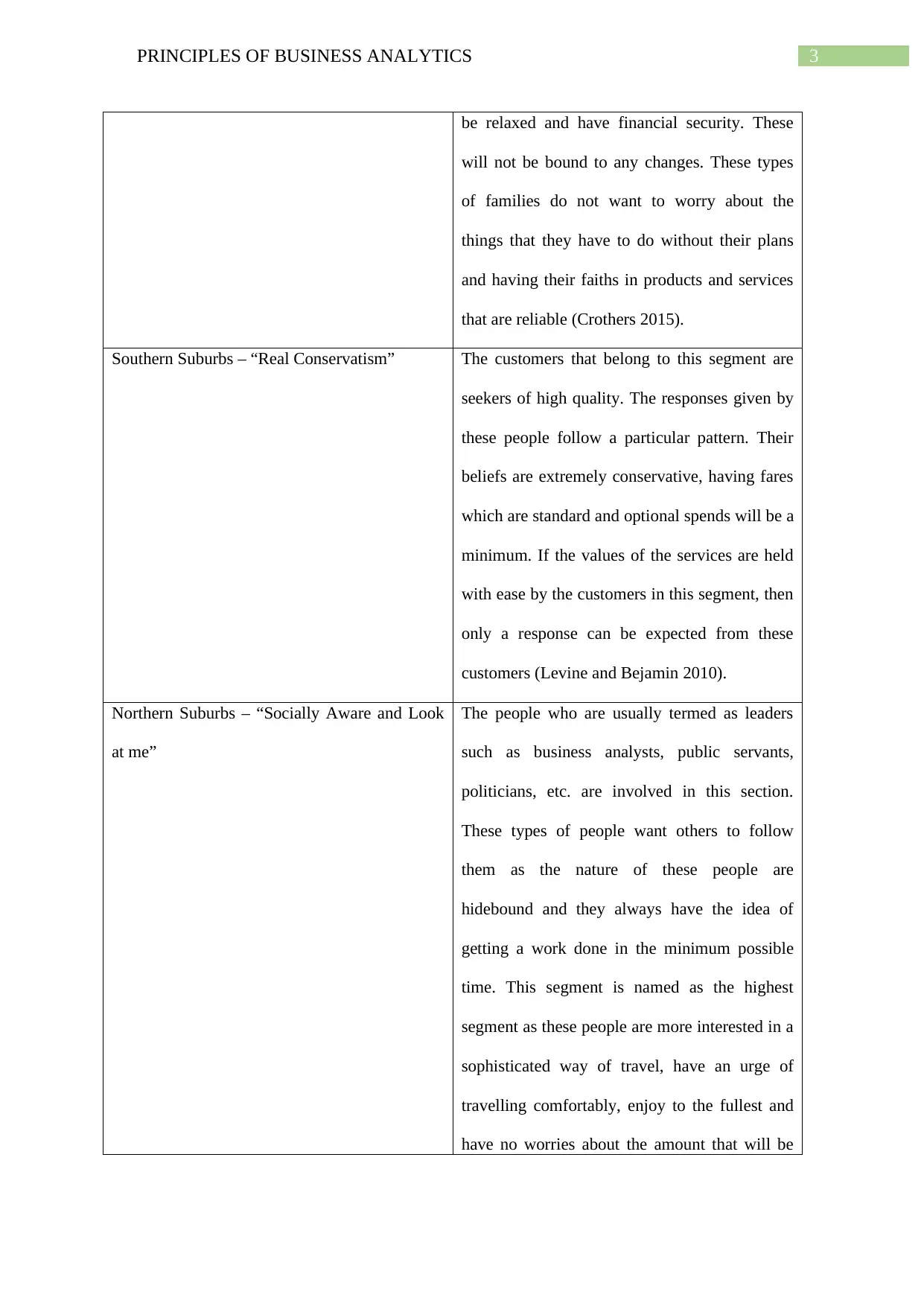
3PRINCIPLES OF BUSINESS ANALYTICS
be relaxed and have financial security. These
will not be bound to any changes. These types
of families do not want to worry about the
things that they have to do without their plans
and having their faiths in products and services
that are reliable (Crothers 2015).
Southern Suburbs – “Real Conservatism” The customers that belong to this segment are
seekers of high quality. The responses given by
these people follow a particular pattern. Their
beliefs are extremely conservative, having fares
which are standard and optional spends will be a
minimum. If the values of the services are held
with ease by the customers in this segment, then
only a response can be expected from these
customers (Levine and Bejamin 2010).
Northern Suburbs – “Socially Aware and Look
at me”
The people who are usually termed as leaders
such as business analysts, public servants,
politicians, etc. are involved in this section.
These types of people want others to follow
them as the nature of these people are
hidebound and they always have the idea of
getting a work done in the minimum possible
time. This segment is named as the highest
segment as these people are more interested in a
sophisticated way of travel, have an urge of
travelling comfortably, enjoy to the fullest and
have no worries about the amount that will be
be relaxed and have financial security. These
will not be bound to any changes. These types
of families do not want to worry about the
things that they have to do without their plans
and having their faiths in products and services
that are reliable (Crothers 2015).
Southern Suburbs – “Real Conservatism” The customers that belong to this segment are
seekers of high quality. The responses given by
these people follow a particular pattern. Their
beliefs are extremely conservative, having fares
which are standard and optional spends will be a
minimum. If the values of the services are held
with ease by the customers in this segment, then
only a response can be expected from these
customers (Levine and Bejamin 2010).
Northern Suburbs – “Socially Aware and Look
at me”
The people who are usually termed as leaders
such as business analysts, public servants,
politicians, etc. are involved in this section.
These types of people want others to follow
them as the nature of these people are
hidebound and they always have the idea of
getting a work done in the minimum possible
time. This segment is named as the highest
segment as these people are more interested in a
sophisticated way of travel, have an urge of
travelling comfortably, enjoy to the fullest and
have no worries about the amount that will be
Paraphrase This Document
Need a fresh take? Get an instant paraphrase of this document with our AI Paraphraser
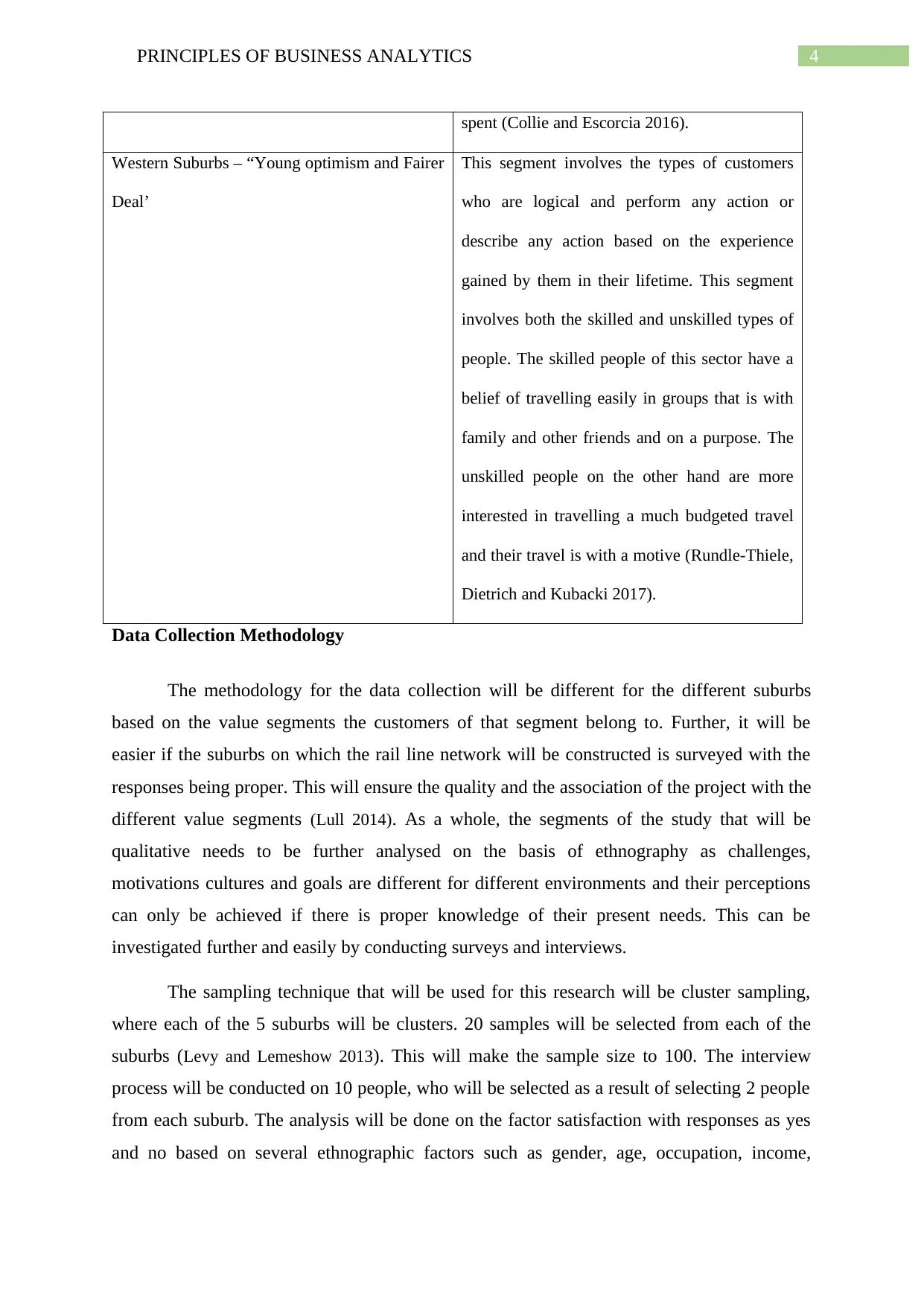
4PRINCIPLES OF BUSINESS ANALYTICS
spent (Collie and Escorcia 2016).
Western Suburbs – “Young optimism and Fairer
Deal’
This segment involves the types of customers
who are logical and perform any action or
describe any action based on the experience
gained by them in their lifetime. This segment
involves both the skilled and unskilled types of
people. The skilled people of this sector have a
belief of travelling easily in groups that is with
family and other friends and on a purpose. The
unskilled people on the other hand are more
interested in travelling a much budgeted travel
and their travel is with a motive (Rundle-Thiele,
Dietrich and Kubacki 2017).
Data Collection Methodology
The methodology for the data collection will be different for the different suburbs
based on the value segments the customers of that segment belong to. Further, it will be
easier if the suburbs on which the rail line network will be constructed is surveyed with the
responses being proper. This will ensure the quality and the association of the project with the
different value segments (Lull 2014). As a whole, the segments of the study that will be
qualitative needs to be further analysed on the basis of ethnography as challenges,
motivations cultures and goals are different for different environments and their perceptions
can only be achieved if there is proper knowledge of their present needs. This can be
investigated further and easily by conducting surveys and interviews.
The sampling technique that will be used for this research will be cluster sampling,
where each of the 5 suburbs will be clusters. 20 samples will be selected from each of the
suburbs (Levy and Lemeshow 2013). This will make the sample size to 100. The interview
process will be conducted on 10 people, who will be selected as a result of selecting 2 people
from each suburb. The analysis will be done on the factor satisfaction with responses as yes
and no based on several ethnographic factors such as gender, age, occupation, income,
spent (Collie and Escorcia 2016).
Western Suburbs – “Young optimism and Fairer
Deal’
This segment involves the types of customers
who are logical and perform any action or
describe any action based on the experience
gained by them in their lifetime. This segment
involves both the skilled and unskilled types of
people. The skilled people of this sector have a
belief of travelling easily in groups that is with
family and other friends and on a purpose. The
unskilled people on the other hand are more
interested in travelling a much budgeted travel
and their travel is with a motive (Rundle-Thiele,
Dietrich and Kubacki 2017).
Data Collection Methodology
The methodology for the data collection will be different for the different suburbs
based on the value segments the customers of that segment belong to. Further, it will be
easier if the suburbs on which the rail line network will be constructed is surveyed with the
responses being proper. This will ensure the quality and the association of the project with the
different value segments (Lull 2014). As a whole, the segments of the study that will be
qualitative needs to be further analysed on the basis of ethnography as challenges,
motivations cultures and goals are different for different environments and their perceptions
can only be achieved if there is proper knowledge of their present needs. This can be
investigated further and easily by conducting surveys and interviews.
The sampling technique that will be used for this research will be cluster sampling,
where each of the 5 suburbs will be clusters. 20 samples will be selected from each of the
suburbs (Levy and Lemeshow 2013). This will make the sample size to 100. The interview
process will be conducted on 10 people, who will be selected as a result of selecting 2 people
from each suburb. The analysis will be done on the factor satisfaction with responses as yes
and no based on several ethnographic factors such as gender, age, occupation, income,

5PRINCIPLES OF BUSINESS ANALYTICS
culture and marital status. Further, the research will be based on variables that are related to
culture, such as travel, with responses being domestic and international, opportunities, with
responses being business or leisure, goals with responses being short term or long term,
values of money with responses being spendthrift or miser and activities of lifestyle with
responses being traveller or home person. The specific of rail line will be taken into
consideration for each of the responses.
Further examination of the research can be conducted based on the use of various
statistical tools such as descriptive statistics which involve mean, median, standard deviation
etc., line plots which will indicate the relationship between the variables (Ott and Longnecker
2015). Confidence intervals and the Pareto principle can be used for the evaluation of the
replications that are involved in the study, specifically on the value segments (Vardeman and
Jobe 2016).
culture and marital status. Further, the research will be based on variables that are related to
culture, such as travel, with responses being domestic and international, opportunities, with
responses being business or leisure, goals with responses being short term or long term,
values of money with responses being spendthrift or miser and activities of lifestyle with
responses being traveller or home person. The specific of rail line will be taken into
consideration for each of the responses.
Further examination of the research can be conducted based on the use of various
statistical tools such as descriptive statistics which involve mean, median, standard deviation
etc., line plots which will indicate the relationship between the variables (Ott and Longnecker
2015). Confidence intervals and the Pareto principle can be used for the evaluation of the
replications that are involved in the study, specifically on the value segments (Vardeman and
Jobe 2016).
⊘ This is a preview!⊘
Do you want full access?
Subscribe today to unlock all pages.

Trusted by 1+ million students worldwide
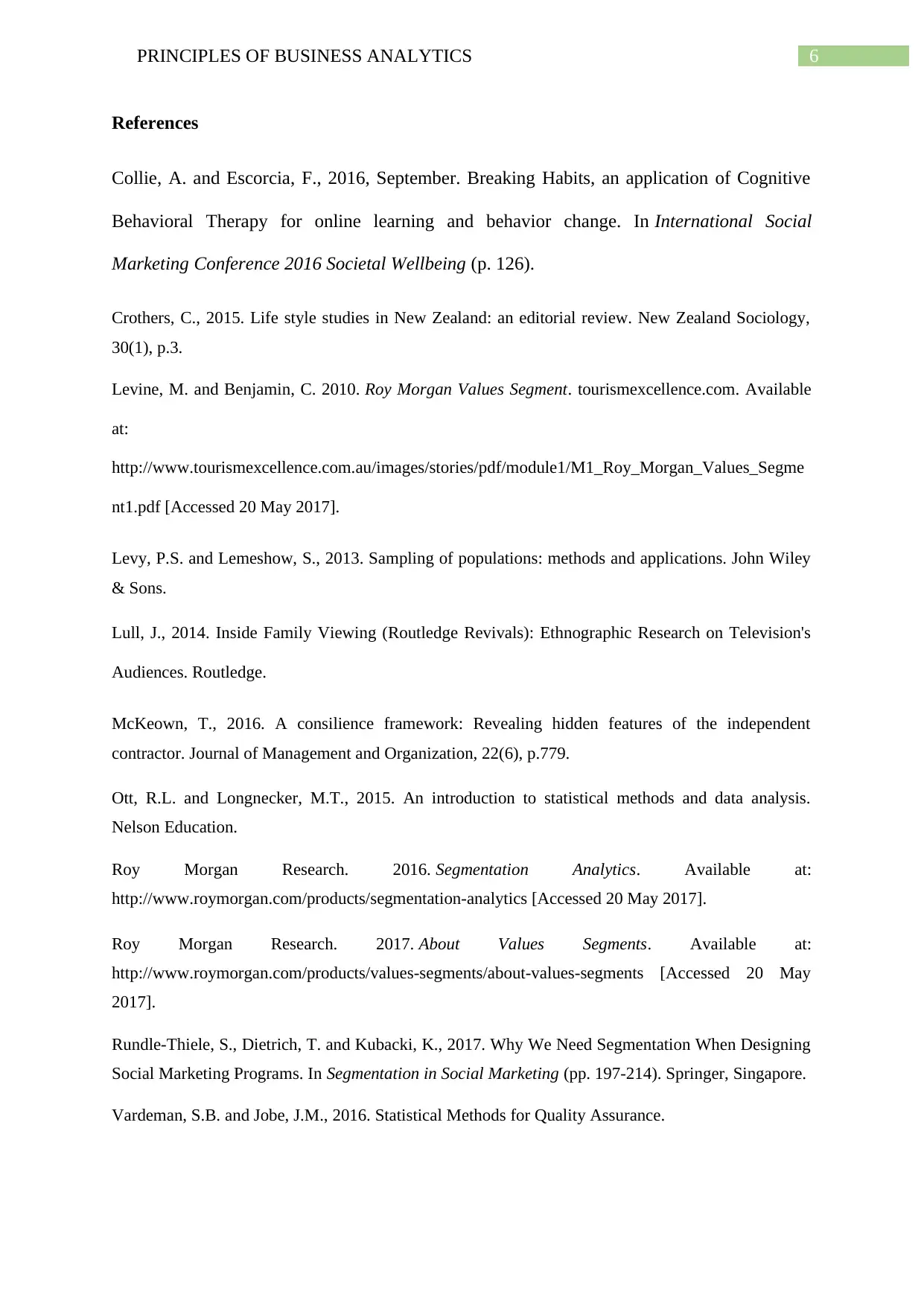
6PRINCIPLES OF BUSINESS ANALYTICS
References
Collie, A. and Escorcia, F., 2016, September. Breaking Habits, an application of Cognitive
Behavioral Therapy for online learning and behavior change. In International Social
Marketing Conference 2016 Societal Wellbeing (p. 126).
Crothers, C., 2015. Life style studies in New Zealand: an editorial review. New Zealand Sociology,
30(1), p.3.
Levine, M. and Benjamin, C. 2010. Roy Morgan Values Segment. tourismexcellence.com. Available
at:
http://www.tourismexcellence.com.au/images/stories/pdf/module1/M1_Roy_Morgan_Values_Segme
nt1.pdf [Accessed 20 May 2017].
Levy, P.S. and Lemeshow, S., 2013. Sampling of populations: methods and applications. John Wiley
& Sons.
Lull, J., 2014. Inside Family Viewing (Routledge Revivals): Ethnographic Research on Television's
Audiences. Routledge.
McKeown, T., 2016. A consilience framework: Revealing hidden features of the independent
contractor. Journal of Management and Organization, 22(6), p.779.
Ott, R.L. and Longnecker, M.T., 2015. An introduction to statistical methods and data analysis.
Nelson Education.
Roy Morgan Research. 2016. Segmentation Analytics. Available at:
http://www.roymorgan.com/products/segmentation-analytics [Accessed 20 May 2017].
Roy Morgan Research. 2017. About Values Segments. Available at:
http://www.roymorgan.com/products/values-segments/about-values-segments [Accessed 20 May
2017].
Rundle-Thiele, S., Dietrich, T. and Kubacki, K., 2017. Why We Need Segmentation When Designing
Social Marketing Programs. In Segmentation in Social Marketing (pp. 197-214). Springer, Singapore.
Vardeman, S.B. and Jobe, J.M., 2016. Statistical Methods for Quality Assurance.
References
Collie, A. and Escorcia, F., 2016, September. Breaking Habits, an application of Cognitive
Behavioral Therapy for online learning and behavior change. In International Social
Marketing Conference 2016 Societal Wellbeing (p. 126).
Crothers, C., 2015. Life style studies in New Zealand: an editorial review. New Zealand Sociology,
30(1), p.3.
Levine, M. and Benjamin, C. 2010. Roy Morgan Values Segment. tourismexcellence.com. Available
at:
http://www.tourismexcellence.com.au/images/stories/pdf/module1/M1_Roy_Morgan_Values_Segme
nt1.pdf [Accessed 20 May 2017].
Levy, P.S. and Lemeshow, S., 2013. Sampling of populations: methods and applications. John Wiley
& Sons.
Lull, J., 2014. Inside Family Viewing (Routledge Revivals): Ethnographic Research on Television's
Audiences. Routledge.
McKeown, T., 2016. A consilience framework: Revealing hidden features of the independent
contractor. Journal of Management and Organization, 22(6), p.779.
Ott, R.L. and Longnecker, M.T., 2015. An introduction to statistical methods and data analysis.
Nelson Education.
Roy Morgan Research. 2016. Segmentation Analytics. Available at:
http://www.roymorgan.com/products/segmentation-analytics [Accessed 20 May 2017].
Roy Morgan Research. 2017. About Values Segments. Available at:
http://www.roymorgan.com/products/values-segments/about-values-segments [Accessed 20 May
2017].
Rundle-Thiele, S., Dietrich, T. and Kubacki, K., 2017. Why We Need Segmentation When Designing
Social Marketing Programs. In Segmentation in Social Marketing (pp. 197-214). Springer, Singapore.
Vardeman, S.B. and Jobe, J.M., 2016. Statistical Methods for Quality Assurance.
1 out of 7
Related Documents
Your All-in-One AI-Powered Toolkit for Academic Success.
+13062052269
info@desklib.com
Available 24*7 on WhatsApp / Email
![[object Object]](/_next/static/media/star-bottom.7253800d.svg)
Unlock your academic potential
© 2024 | Zucol Services PVT LTD | All rights reserved.




